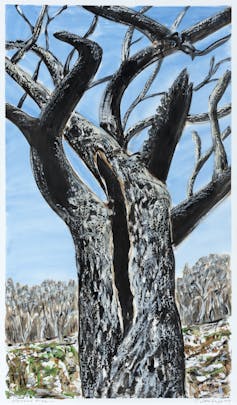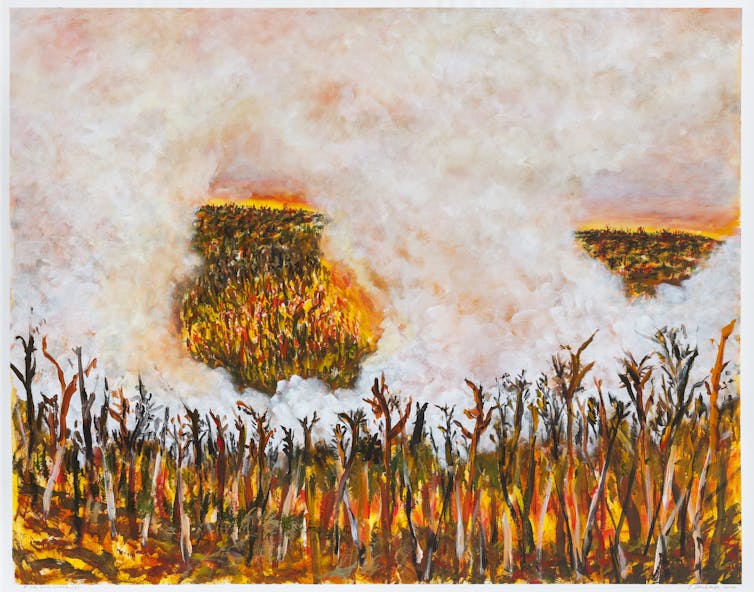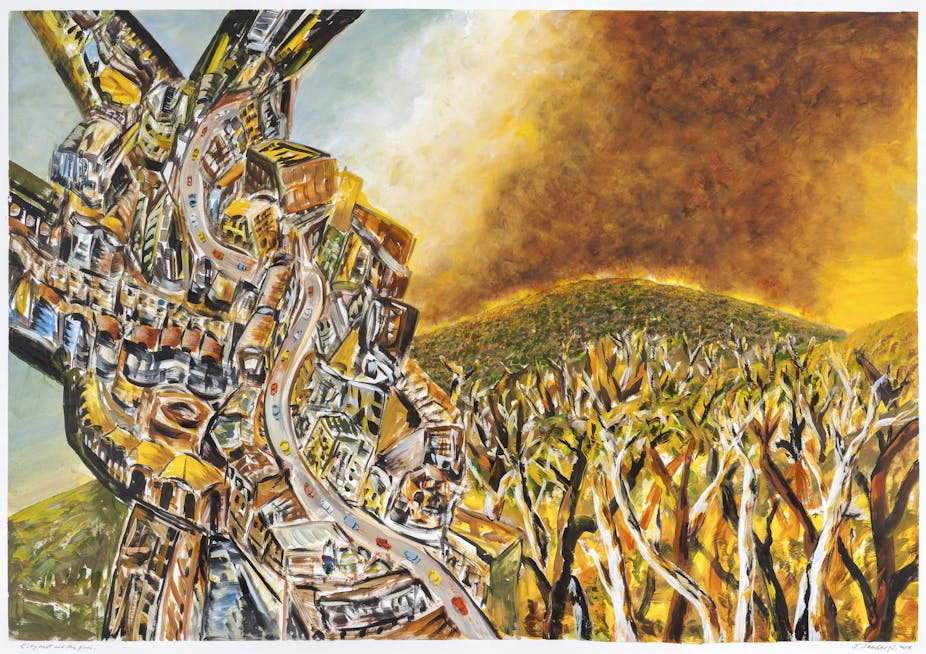Jan Senbergs, who turned 75 last year, is one of the great veteran artists in the Australian art scene and is holding a major exhibition of his recent work at the Niagara Galleries in Melbourne.

Born in Riga, Latvia, Senbergs arrived in Melbourne in 1950 with his widowed mother as part of the post-war flood of migrants. On completing an apprenticeship as a commercial screenprinter, he started to exhibit his paintings and art screenprints in 1960.
From the outset, his art did not belong to any clearly defined popular trend in art, but seemed to be located somewhere on periphery: figurative, but never literal, expressive, but not fashionably expressionist. If there is a unifying thread in his art, it is that it engages with society, its problems and its challenges, both on the level of an individual and within a more holistic and global dimension.
The Australian painter Fred Williams once referred to Senbergs as an “industrial surrealist”. He is an artist whose work is rooted in the real industrial landscape of his immediate environment – yet it is informed by that strange creative process of the disjunction of unexpected elements that is central to surrealist practice. Confronting and subverting reality have remained constant in Senbergs’ art making.
For an artist who has had such lengthy and extensive practice, one which has stretched for more than half a century, the question arises of how to proceed without falling into the trap of repetition. TS Eliot in a 1940 lecture on the poet WB Yeats spoke of the dilemma facing a creative person in mature years. He wrote:
a man has three choices: to stop writing altogether, to repeat himself with perhaps an increasing skill of virtuosity, or by taking thought to adapt himself to middle age and find a different way of working … Most men either cling to the experiences of youth, so that their writing becomes an insincere mimicry of their earlier work, or they leave their passion behind, and write only from the head, with a hollow and wasted virtuosity.
In this exhibition Senbergs has sought a different way of working and has branched out into a warm and glowing chromatic brilliance, which has not been previously encountered in his oeuvre.
Although concern with the world’s threatened ecology and global warming are themes that have reoccurred in his art, for example in the Mt Lyell mining landscape paintings and in the Antarctica series, this exhibition looks at the present and at the real threat posed by climate change and adopts a somewhat eschatological note.
Senbergs notes in his catalogue essay:
In January 2014 in Melbourne, we had four days of forty plus degrees of intense heat – with bushfires raging in the countryside casting a pall of acrid smoke over the extended city, and all around ominous skies that seemed to portend an inferno that would be all engulfing. That oppressive atmosphere and that sense of threat at the edges of the extended city seemed as if an overwhelming and merciless force was at the gates and ready to break down the barricades.

This is an exhibition with a huge “wow” factor – a shock to the senses – something that we have forgotten that figurative painting can achieve.
The large paintings in the upstairs gallery, especially Fire and smoke 2 (2014) and City, heat and the fires (2014 - main image) have an enormous sense of dramatic presence. Senbergs has the rare ability to operate on a grand scale with a seemingly spontaneous gestural freedom and an inventive compositional boldness.
The smaller works, in the downstairs gallery, operate on a different set of principles. The intimacy in the viewing distance results in the closer reading of the gestural mark-making, as we can follow the passion of the emotion-laden brushstrokes.
The brilliant smaller paintings, including Still we stand – January 2014 (2014) and Wounded tree (2014), possess a rich colour saturation and a wonderfully tactile surface. His visceral, chunky surfaces reproduce poorly, but have an immediate impact when seen in the flesh.

More than half a century ago Arthur Boyd painted his apocalyptic image of Melbourne burning, like a Biblical narrative in the context of the second world war. Senbergs’ powerful reinterpretation of Melbourne under a blood-red sky presents the theme in a contemporary and an even more frightening context. Through greed and stupidity, we as a society ignore the reality of climate change and now anticipate the consequences as an inevitability.
Jan Senbergs is one of the elders in Australian art. He has never been a fashionable artist nor a prized show pony of the art market, but this exhibition demonstrates that as a painter, he has few equals in Australia art today.
Fortunately that National Gallery of Victoria has embarked on an enlightened policy of holding major retrospective exhibitions of some of the great veterans of Australian art. We presently have the wonderful Robert Jacks retrospective to be followed by John Wolseley in April. It will finally be Senbergs’ turn early next year.
Jan Senberg’s exhibition Heat - Fire - Smoke is on display at Melbourne’s Niagara Galleries until February 28. Details here.

